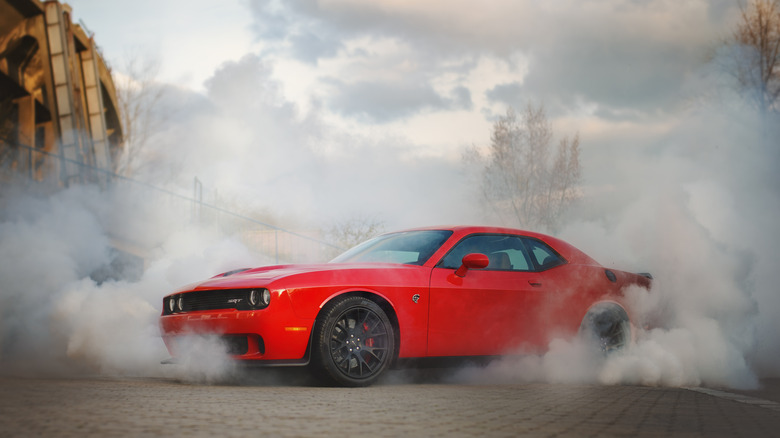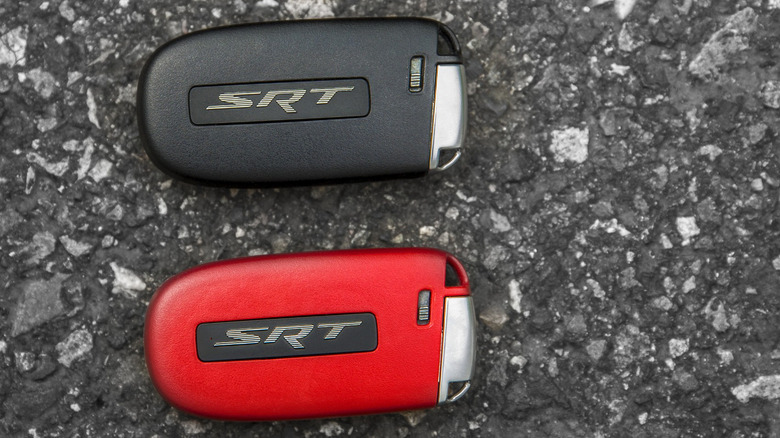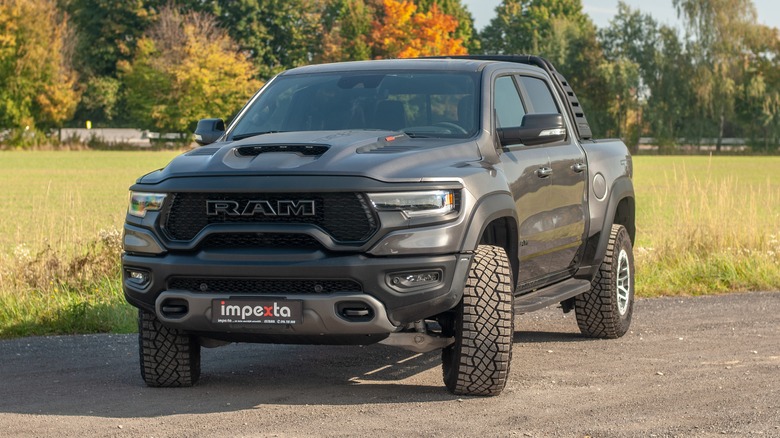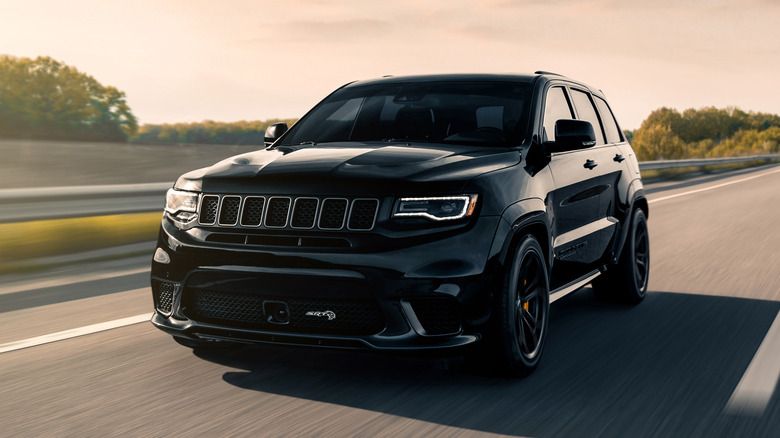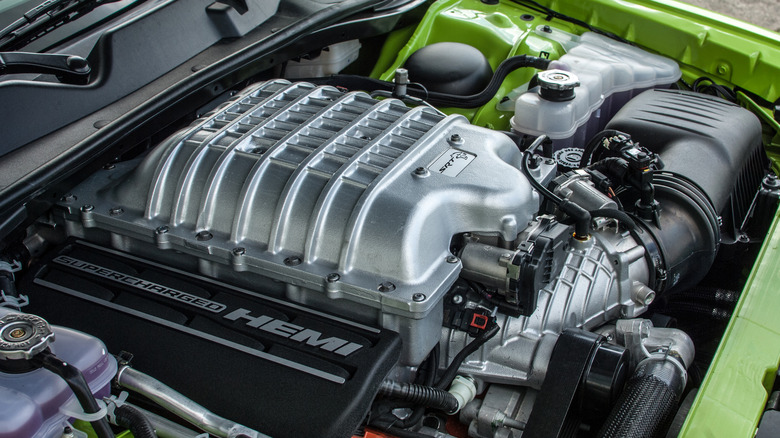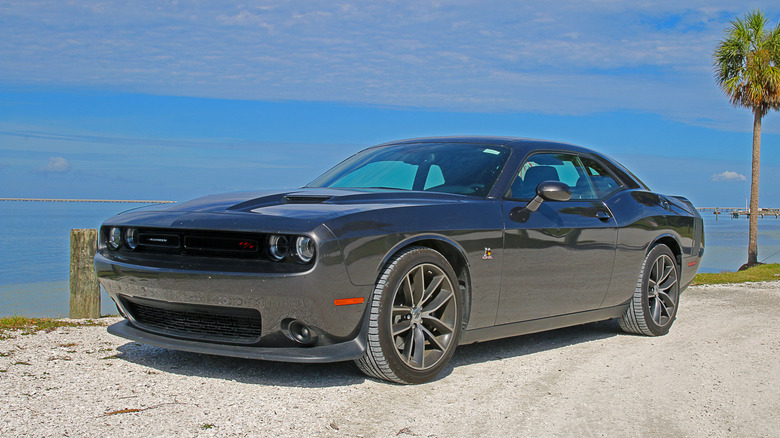5 Facts Every Dodge Fan Should Know About The Legendary Hellcat Engine
This year marks the end of the road for the Hellcat engine as we know it. The infamous name may live on in a hybrid or electric form, but for now, at least, the Hellcat is not long for this world in its current form.
Saying goodbye to one of the most outrageous car engines to ever have lived won't be easy. Named after the Grumman F6F Hellcat — a carrier-based U.S. Navy fighter aircraft from World War 2 — the supercharged V8 engine first appeared in the 2015 Dodge Challenger SRT Hellcat. It had a capacity of 6.2 liters (376 cubic inches), and was rated at 707 horsepower with 650 foot-pounds of torque.
The engine appears most notably in the SRT variants of the Dodge Challenger and Charger, but was also used by the Ram 1500 TRX truck and the Jeep Grand Cherokee Trackhawk SUV, among others.
Before we have to bid farewell to the supercharged V8, here's a look at some Hellcat facts every Dodge fan should know about the legendary engine. From needing two key fobs, to its insatiable thirst for gas and how powerful the supercharger is, there's a reason why the Hellcat engine heralded the final push for extremely fast American muscle cars.
Two keys: Black for valet, red for full power
Would you want a hotel valet or your teenager to jump behind the wheel of your 700-horsepower car and see what that Hellcat motor is all about? Probably not. That's exactly why some models of Hellcat, like the Dodge Challenger SRT, come with two different keys.
When the car is unlocked with the red key it'll give you the full 707 horsepower, no questions asked. There's a message on the dashboard display reminding you of the power under your right foot, but otherwise you're good to go responsibly.
Unlock your Hellcat with the black key, however, and the engine will be wound down to "only" 500 horsepower. That's still a huge amount of power, but trims back the car's performance to something more manageable for unfamiliar drivers. The Dodge Hellcat is in good company here, as other cars to famously have two keys include the Bugatti Veyron and Chiron, where the second "speed key" is required to reach top speed.
The gas tank can run dry in just 11 minutes
A similarly Bugatti-esque Hellcat fact is how quickly it'll drain its gas tank under full power. According to J.D Power, the Charger SRT Hellcat Redeye can drain its entire gas tank in just 11 minutes. That's thanks to dual-stage fuel pumps that help its 6.2-liter Hemi V8 gulp down dinosaur juice at a rate of 1.43 gallons (5.4 liters) per minute.
Despite this ferocious appetite for gas, the Hellcat Redeye can manage up to 22 miles per gallon, presumably only when the driver deploys their right foot with the delicacy of a ballerina.
While we're on the Redeye, it's worth adding how this model — released for the 2021 model year — ups the power of its Hellcat motor to 797 horsepower with 707 foot-pounds of torque. The insane truck has a top speed of 203 mph, and a 0-60 mph time of 3.4 seconds. The rev limiter is also increased for the Redeye, from 6,200 to 6,500 rpm, and the supercharger is increased from 2.4 to 2.7 liters. Boost pressure is up considerably, from 11.6 to 14.5 psi.
As well as gas, the Hellcat has a big appetite for air. The Redeye features a larger induction air box fed by three sources of air, in the form of a uniquely-designed hood, a mail-slot grille opening, and an air box opening near the wheel liner.
The fuel injectors can fill a pint glass in seven seconds
Given how the Hellcat can empty its fuel tank in just 11 minutes, you'd expect it to have some pretty speedy fuel injectors. The Hellcat makes use of port fuel injection, instead of direct injection, and sprays 38.4 cubic-inches of gasoline per minute through eight injectors.
Speaking in 2014, then-director of Chrysler's SRT Powertrain department Chris Cowland told Wards Auto: "If you put all eight injectors into a pint glass, they would fill it in seven seconds at rated power."
But the V8 engine itself is only half of the Hellcat story, there's also the supercharger. Driven from the front crankshaft, it produces 11.6 psi (or 14.5 psi in souped-up Redeye trim) and displaces 0.54 gallons of air with each rotation. According to Wards Auto, the supercharger spins at up to 14,600 rpm when the engine is running at 6,000 rpm, and every minute it's moving just over 1,000 cubic feet of air.
Built in Mexico
It might be the definitive example of an American muscle car engine, but the Hellcat is actually produced in Mexico. More specifically, the motors are assembled at the Saltillo Engine Plant — owned by Stellantis, parent company of Chrysler, Dodge, Jeep, Ram and others.
Located in Coahuila, Mexico, the 42-year-old plant has 1.2 million square feet of floor space, and sits on a site spanning 73.9 acres. Just over 2,000 employees work there, and along with the Hellcat, they assemble 3.0-liter twin-turbos for the Wagoneer, a 5.7-liter V8 used by several Dodge Ram trucks, the 6.4-liter V8 Apache for the Jeep Grand Cherokee SRT, and the BGE Hemi for the Ram Heavy Duty 2500 and 3500.
Each 6.3-liter Hemi Hellcat engine is run-in on a dynamometer for 42 minutes before being shipped off to whichever vehicle assembly plant needs it. In the case of the Dodge Charger SRT, that's a Chrysler Group assembly plant in Brampton, Ontario, Canada.
Where the engine goes for installation can vary, since the Hellcat is used by a range of Stellantis group vehicles. These include the Ram 1500 TRX truck, Jeep Grand Cherokee Trackhawk, Dodge Durango SRT Hellcat, plus several models of Dodge Challenger and Charger.
Only one Hellcat is offered as a manual
Want all that power with a stick shift, do you? Clearly you have a larger budget for fresh rear tires than we do, and thankfully you're in luck. For 2023, Dodge has reintroduced a six-speed manual transmission option for the Challenger Hellcat.
The option disappeared in late-2022, with Dodge blaming powertrain calibration issues, as reported by Car and Driver at the time. This was described as a temporary issue and, sure enough, about a year later in late-2022, the manual transmission option returned.
At a time when car manufacturers are increasingly reluctant to offer manual options, especially with high-performance vehicles, stick-shift Hellcats are surprisingly popular. In 2018, Dodge had stated that 35% of Hellcat buyers tick the manual box when configuring their new ride.
We all know shifting gears manually isn't as fast as an auto, and in heavy traffic you can be sure those Hellcat buyers would long for the extra comfort of the optional eight-speed automatic. However, when you're buying a muscle car with over 700 horsepower, you surely want to feel as connected as possible to that massive V8 engine.
